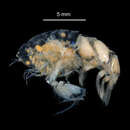Comprehensive Description
(
Inglês
)
fornecido por Smithsonian Contributions to Zoology
Primno macropa Guérin-Méneville
Primno macropa Guérin-Méneville, 1836:4, pl. 17: fig. la–f.—Bovallius, 1887:28.—?Spandl, 1927:168–169.—Barnard, 1930: 424–425 [at least larger specimens—up to 12 mm]; 1932: 287–288 [except 6 and 7 mm ovig. ], pl. 1: fig. 8.—Mackintosh, 1934, passim.—Hardy and Gunther, 1935, passim.—Thorsteinson, 1941:93–94, figs. 98–102.—Hurley, 1955:172–174, figs. 219–235; 1969:33, map 7.—Vinogradov, 1956:209; 1962:22.—Yoo, 1971a:59 [part]; 1971b: passim; 1972a: passim [part]; 1972b:174–175 [part.].—Sanger, 1973:20; 1974:7.—Lorz and Pearcy, 1975: 1445–1446.
Primno menevillei Stebbing, 1888:1447–1448, pl. 179, B.
Primno antarctica Stebbing, 1888:1448–1451, pl. 209, B.
Euprimno macropus (Guérin-Méneville).—Bovallius, 1889:400–407 [part].—Walker, 1907:9.—Wailes, 1929:161; 1931:41; 1933:9.—Behning, 1939:363.
Euprimno abyssalis Bowman.—Fulton, 1968:104, 109.
Euprimno macropa Guérin-Méneville var. menevillei Stebbing.—Monod, 1926:50–51, fig. 49.
ETYMOLOGY.—From Guérin-Méneville's center heading, “P. à grands pieds. P. Macropa. Guérin,” it is clear that the specific name “macropa” is composed of μαχρoσ (large) and Πoνσ (foot), and should have been transliterated as macropus. Guérin-Méneville apparently changed its ending from -us to -a to make it agree in gender with the feminine Primno. Bovallius (1889) was linguistically correct in changing macropa to macropus, but subsequent authors continued to use macropa, perhaps intimidated by Stebbing's (1904) admonition “that macropus is a more scholarly form than macropa must be admitted, but the practice of polishing and improving the names which our scientific ancestors invented has to my mind the same effect as daylight upon Melrose Abbey, where the rays of the sun ‘gild but to flout the ruins grey.’”
Stebbing's view is supported by Article 32(a)(ii) of the International Code of Zoological Nomenclature, which prohibits correction of an original spelling because of incorrect transliteration. Guérin-Méneville's spelling is therefore the “correct original spelling” as defined by Article 32(a).
DIAGNOSIS.—Body narrow, up to 21 mm in length. Rostrum truncate in dorsal view. Pereon about 3.3× as long as head, slightly longer than pleon. Middorsal spines and posteroventral spine of pleonite 3 sharper and more pronounced than in other species of Primno. Antenna 1 slightly longer than head. Buccal mass about 2/3 height of head. Pereopod 5 basis nearly 3× as long as broad; carpus slightly longer than basis, proximal 1–2 teeth short, long teeth slightly shorter than width of carpus; short teeth about as long as width of gently curved propus. Peropod 6 basis slightly more than 1/3 as wide as long, narrowed proximately, proximal part of anterior margin concave; ischium, merus and carpus narrower than in other species of Primno; propus armed with spinules on anterior and posterior margins. Pereopod 7 basis about as long as remaining segments combined. Uropod 3 with well developed medial shoulder.
DISTRIBUTION.—South Atlantic, S of 44°32′S (Barnard, 1932); Antarctic (Barnard, 1930); S of Australia, 48°18′S (Stebbing, 1888); New Zealand (Hurley, 1955); Chile (Guérin-Méneville, 1836); Japan, Okhotsk and Bering Seas (Behning, 1939); western Bering Sea (Vinogradov, 1956); SE Bering Sea (Sanger, 1974); Gulf of Alaska and off Nanaimo, B.C. (Thorsteinson, 1941); Strait of Georgia, British Columbia (Fulton, 1968); British Columbia (Wailes, 1929, 1931, 1933); British Columbia and Washington (Sanger, 1973); Oregon (Lorz and Pearcy, 1975).
In the CalCOFI area P. macropa was not taken on Cruise 20, which did not extend north of Point Conception. In the other cruises it occurred almost entirely north of Point Conception and was most abundant at the northern stations. Only 3 adults, all females, were taken on these CalCOFI cruises; the remaining specimens were juveniles, 3–7 mm long. The adult population presumably lives at greater depths than the 70–0 m layer sampled.
The collections of the Smithsonian Institution contain a from Eltanin station 138, N of the South Shetland Islands (ca. 62°S, 61°W). The head is missing, and the body length without the head is about 16 mm.
- citação bibliográfica
- Bowman, Thomas E. 1978. "Revision of the pelagic amphipod genus Primo (Hyperiidea: Phrosinidae)." Smithsonian Contributions to Zoology. 1-23. https://doi.org/10.5479/si.00810282.275

